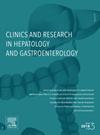Trends in esophageal cancer mortality in the United States (1999–2024): Disparities by sex, race/ethnicity, region, and urbanization
IF 2.4
4区 医学
Q2 GASTROENTEROLOGY & HEPATOLOGY
Clinics and research in hepatology and gastroenterology
Pub Date : 2025-09-22
DOI:10.1016/j.clinre.2025.102691
引用次数: 0
Abstract
Background
Esophageal carcinoma is the seventh most common cancer worldwide and poses a significant public health concern due to its poor overall survival rates. Although treatment advances, including multimodal approaches and enhanced surgical techniques, have emerged, their effect on national mortality trends remains unclear. Understanding the temporal changes in esophageal cancer mortality and potential disparities across demographic and geographic subgroups is crucial for guiding targeted interventions and resource allocation.
Methods
We obtained mortality data for esophageal cancer from the CDC WONDER database covering the years 1999 to 2020, using the ICD-10 code (C15) for malignant neoplasm of the esophagus. Annual mortality rates were age-adjusted to the 2000 U.S. standard population and expressed per 10,000 and 100,000 persons. Analyses were stratified by sex (male, female), race/ethnicity (Non-Hispanic Black or African American, Non-Hispanic White, Hispanic), U.S. Census region (Northeast, Midwest, South, West), and urbanization status (rural versus urban). Joinpoint regression identified periods with distinct trends and estimated annual percent changes (APC); the average annual percent change (AAPC) summarized the overall trend.
Results
From 1999 to 2020, there were 374,000 recorded deaths from esophageal cancer across a population of over 8 billion. The overall AAMR declined from 4.36 (95 % CI: 4.28–4.44) in 1999 to 3.69 (3.63–3.75) in 2020 (AAPC:0.8 %). Sex disparities were observed, as males had significantly higher mortality (6.43 per 100,000) compared to females (1.38 per 100,000) in 2020, though both showed declining trends (AAPC:0.84 % and -1.12 %, respectively). By race/ethnicity, Black or African American individuals experienced the most pronounced decline, from 6.61 to 2.73 (AAPC:3.82 %), with particularly steep declines after 2018 (APC:1.58 %). Hispanic populations showed moderate decreases from 2.54 to 1.99 (AAPC:1.32 %), while White populations showed minimal change from 4.3 to 4.28 (AAPC:0.05 %).
Regionally, the West experienced the greatest decline from 4.17 to 3.36 (AAPC:1.08 %), followed by the Northeast which fell from 4.61 to 3.57 (AAPC:1.07 %), the South from 4.23 to 3.56 (AAPC:0.89 %), and the Midwest displaying the smallest decrease from 4.46 to 4.37 (AAPC:0.31 %). Urban areas demonstrated a consistent decline (AAPC:1.09 %), while rural areas showed a modest increase from 4.16 to 4.52 (AAPC: 0.48 %).
Conclusions
Mortality due to esophageal cancer in the U.S. has declined modestly from 1999 to 2020, showing substantial variation across demographic and geographic subgroups. Black or African American populations experienced a significant decline in mortality rates compared to other racial groups, while rural areas exhibited concerning increases in mortality rates. Persistent disparities by sex, race/ethnicity, and urbanization underscore the need for targeted prevention strategies, early detection initiatives, and enhanced access to specialized care, particularly in rural settings where mortality trends diverge from the national pattern.
美国食管癌死亡率趋势(1999-2024):性别、种族/民族、地区和城市化差异
背景:食管癌是全球第七大常见癌症,由于其较低的总生存率,引起了重大的公共卫生问题。尽管出现了治疗进展,包括多模式方法和改进的手术技术,但它们对国家死亡率趋势的影响仍不清楚。了解食管癌死亡率的时间变化以及不同人口和地理亚群之间的潜在差异对于指导有针对性的干预和资源分配至关重要。方法:采用食道恶性肿瘤的ICD-10编码(C15),从CDC WONDER数据库中获取1999年至2020年食管癌死亡率数据。年死亡率根据2000年美国标准人口进行年龄调整,并以每1万人和每10万人表示。分析按性别(男性、女性)、种族/民族(非西班牙裔黑人或非裔美国人、非西班牙裔白人、西班牙裔)、美国人口普查地区(东北部、中西部、南部、西部)和城市化状况(农村与城市)进行分层。结合点回归确定了具有明显趋势的时期和估计的年百分比变化(APC);平均年变化百分比(AAPC)概括了总体趋势。结果:从1999年到2020年,在超过80亿的人口中,有374,000人死于食道癌。总体AAMR从1999年的4.36 (95% CI: 4.28-4.44)下降到2020年的3.69 (3.63-3.75)(AAPC: -0.8%)。性别差异也被观察到,2020年男性的死亡率(6.43 / 10万)明显高于女性(1.38 / 10万),尽管两者都呈现下降趋势(AAPC分别为-0.84%和-1.12%)。按种族/民族划分,黑人或非洲裔美国人的下降最为明显,从6.61降至2.73 (AAPC: -3.82%), 2018年之后的下降尤为急剧(APC: -1.58%)。西班牙裔从2.54下降到1.99 (AAPC: -1.32%),白人从4.3下降到4.28 (AAPC: -0.05%)。从地区来看,西部从4.17下降到3.36 (AAPC: -1.08%),降幅最大,其次是东北从4.61下降到3.57 (AAPC: -1.07%),南部从4.23下降到3.56 (AAPC: -0.89%),中西部从4.46下降到4.37 (AAPC: -0.31%),降幅最小。城市地区表现出持续的下降(AAPC: -1.09%),而农村地区则从4.16小幅上升到4.52 (AAPC: 0.48%)。结论:从1999年到2020年,美国食管癌死亡率略有下降,在人口统计学和地理亚组中显示出实质性的变化。与其他种族群体相比,黑人或非洲裔美国人的死亡率大幅下降,而农村地区的死亡率则出现了相应的上升。性别、种族/民族和城市化方面的持续差异强调需要有针对性的预防战略、早期发现举措和增加获得专门护理的机会,特别是在死亡率趋势与全国模式不同的农村地区。
本文章由计算机程序翻译,如有差异,请以英文原文为准。
求助全文
约1分钟内获得全文
求助全文
来源期刊

Clinics and research in hepatology and gastroenterology
GASTROENTEROLOGY & HEPATOLOGY-
CiteScore
4.30
自引率
3.70%
发文量
198
审稿时长
42 days
期刊介绍:
Clinics and Research in Hepatology and Gastroenterology publishes high-quality original research papers in the field of hepatology and gastroenterology. The editors put the accent on rapid communication of new research and clinical developments and so called "hot topic" issues. Following a clear Editorial line, besides original articles and case reports, each issue features editorials, commentaries and reviews. The journal encourages research and discussion between all those involved in the specialty on an international level. All articles are peer reviewed by international experts, the articles in press are online and indexed in the international databases (Current Contents, Pubmed, Scopus, Science Direct).
Clinics and Research in Hepatology and Gastroenterology is a subscription journal (with optional open access), which allows you to publish your research without any cost to you (unless you proactively chose the open access option). Your article will be available to all researchers around the globe whose institution has a subscription to the journal.
 求助内容:
求助内容: 应助结果提醒方式:
应助结果提醒方式:


